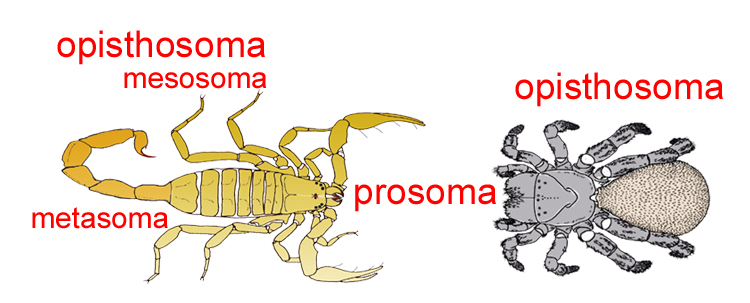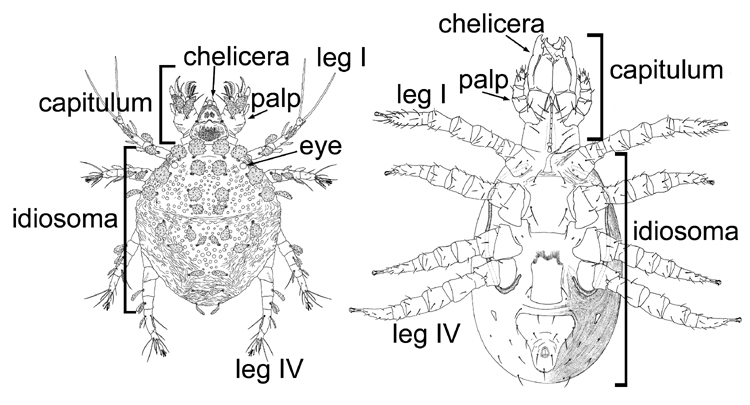
BODY REGIONS & LIMBS
The key to the major lineages of Arthropoda is understanding how segments have coalesced into functional body regions (tagma, tagmata) during their evolution and how the limbs of those segments have been modified. For example, hexapods (springtails, diplurans, proturans, insects) have three distinct body regions: head (sensing, feeding), thorax with 3 pairs of legs (movement, respiration) and abdomen (digestion, respiration, reproduction etc.) without functional legs (although sometimes with leg remnants called styli). Myriapods have a head and a trunk (abdomen) with numerous pairs of legs.

Most arachnids have only two body regions and 6 pairs of limbs. The anterior body tagma is called the prosoma (sometimes cephalothorax) and is composed of about six segments, each with a pair of limbs (chelicerae, pedipalps, and four pairs of walking legs). The prosoma combines feeding, sensing and ambulatory functions. That is, arachnids have an anterior body region that combines the functions of the insect head (feeding, sensing) and thorax (locomotion) in one. Behind the prosoma is an opisthosoma (abdomen - subdivided into two regions in scorpions) composed of ca. 12 segments that carries most of the digestive, excretory, respiratory and reproductive systems. The opisthosoma has no true legs, but often bears highly modified remnants of limbs (e.g. book lungs, spinnerets, genital papillae, pectines).

In pseudoscorpions and opilionids the prosoma and opisthosoma are broadly joined, but in spiders and some whipscorpions a narrow pedicel appears to separate the two regions (actually the pedicel is part of the opisthosoma). Scorpions can be distinguished from pseudoscorpions because scorpions have a narrow, tubular tail-like metasoma at the end of the opisthosoma that bears a bulbous sting.
Mites also have two body tagmata, but these differ from most other arachnids. In mites (and a strange group of arachnids known as ricinuleids), the first two segments of the prosoma (bearing the chelicerae and palps) are separated from the remainder of the body by flexible cuticle. This is the gnathosoma ('jaw body') or, because it sometimes looks a bit like a little head, the capitulum. The remainder of the mite body is considered a single tagma, the idiosoma. Mites have lost all primary segmentation, and the juncture between the prosoma and opisthosoma is obscured or visible only dorsally (the dorso-sejugal suture may represent this ancient division). Larval mites are usually hexapod; nymphs and adults octopod. However, some mites have suppressed the last 1-2 pairs of legs in all stages.
